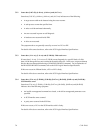
6-14 C141-E166
Table 6.2 System-level field troubleshooting
Item Recommended work
DC power cable Check that the power cable is correctly connected to the disk drive and
power supply unit.
AC and DC power level Check that the DC voltage is within the specified range (±5%).
Check that the +5 VDC value (pins 3 and 4 of the power connector) is
4.75 to 5.25 VDC.
Check that the +12 VDC supply (pins 1 and 2 of the power connector of
disk drive) is 11.4 to 12.6 VDC.
Electrical noise Make sure the maximum ripple peak-to-peak value of +5 VDC is within
250 mV and +12 VDC is within 250 mV.
Interface cable connection Check that the SCSI interface cable is correctly connected between the
disk drive and controller.
Terminating resistors For a daisy chain connection, check the terminating resistor on the last
disk drive only. For a star-burst connection, check that the terminating
resistor is correctly mounted on all disk drives.
Drive selection address Check that the disk drive selection address is set correctly.
Plug setup Check that the jumpers on the PCA are set so that the disk drive and host
computer operate normally. See Section 5.3.
System cables Check that all system cables are connected correctly.
System diagnostic test When possible, execute the system level diagnostic routine as explained
in the host computer manual. This gives a detailed report of a possible
fault.
Intermittent or nonfatal errors Check the AC voltage from the power supply. Check the DC voltage
level at the power connector for the disk drive.
If the AC voltage level is abnormal or there is a lot of electrical noise,
notify the user of the error.
If the DC voltage level is unstable, replace the power supply unit.
If possible, replace the disk drive. If replacing the disk drive does not
eliminate the error, the removed disk drive is probably not faulty. To
continue error analysis, refer to the hardware and software manuals
supplied with the system.


















